 |
This diagram shows the three Steps in creating new Client-specific Data Models to meet Business Requirements.

|
 |
Barry maintains the Database Answers Web Site which offers over 50 Customer-related Data Models, including these for CRM :-
CRM
CRM Marketing_data, including Loyalty Schemes
CRM Metrics, including Loyalty
Here is a selection of Customer-related Enterprise Models from his Web Site ...
- Enterprise Data Model for Retail
- Enterprise Data Model for Retail and TK Maxx (with permission)
- Alternative Enterprise Data Model (Version 2)
- Alternative Enterprise Data Model (Version 3)
- Alternative Events-Oriented Enterprise Data Model (Version 4)
- Conceptual Data Model
- Generic Retail Model
- Retail Customers Data Layers and Entities
- Here’s a Generic Data Warehouse in ERwin
- Here’s a Generic Data Mart in ERwin
- Retail Model – ARTS - compatible
- Canonical Model and Arts
- The ARTS Data Model (a Macro View on the Database Answers Web Site)
- The ARTS Data Model (a description on the ARTS Web Site)
and Dimensional Models (Data Marts)
- Generic Retail Data Warehouse
- Retail Customers Data Mart
- Retail Dimensional Model
- Alternative Retail Customer Data Model
- The ARTS Data Warehouse Model (a description on the ARTS Web Site)
The Customer Experience
A valuable approach is to look at the world through the Customer's eyes.
We have a Model for 'My Life' and My Work
In addition, we have created this one for Customer Experience Management
Engaging with the Business
An important activity is to adapt the Data Foundation to meet the requirements of a new Client.
This tailoring will involve meeting with business users to clarify their requirements and tailoring the Data Foundation accordingly.
This might involve one on one Interviews and running Facilitated Workshops in order to achieve consensus.
Planning timetables will have to allow for these procedures which can be lengthy.
Getting everybody on the same page ("Conflict Resolution")
Some activities, such as agreeing what is in scope, require consensus among a group of people who might have different objectives
and priorities.
There are three techniques that can prove useful to achieve consensus :-
1) Create a friendly relationship with any individual who is one of a few objectors.
However, this technique may not survive the first serious meeting !!!
2) Adopt a ‘pincer movement’ and say ‘Jim, 19 other people are happy with the proposal, it is difficult to defend your position’.
3) Bring in senior management if appropriate.
Barry Williams
Principal Consultant
June 19th. 2013
Database Answers Ltd.
London, England
|
|

